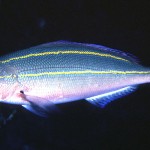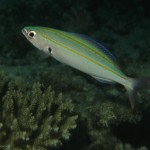Species: Pterocaesio digramma
English Name: Double-lined Fusilier
Chinese Name: 双带鳞鳍梅鲷
Family: Caesionidae
Description:
The body of a Double-Lined Fusilier is blue to greenish dorsally, white ventrally with two thin yellow to orange lines and black tips on caudal fin. Can grow up to a length of 30 cm. Lives mainly around coral reefs and feeds on zooplankton. Used for commercial purpose


Photos used under a Creative Commons license
References:
– Carpenter, K.E., 1987. Revision of the Indo-Pacific fish family Caesionidae (Lutjanoidea), with descriptions of five new species. Indo-Pac. Fish. (15):56 p.

